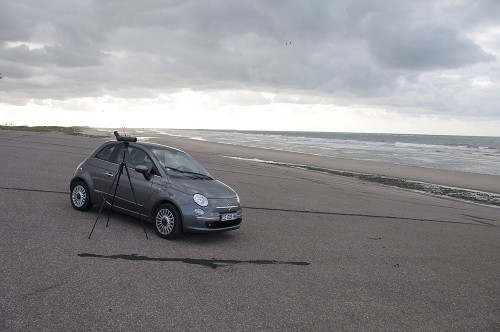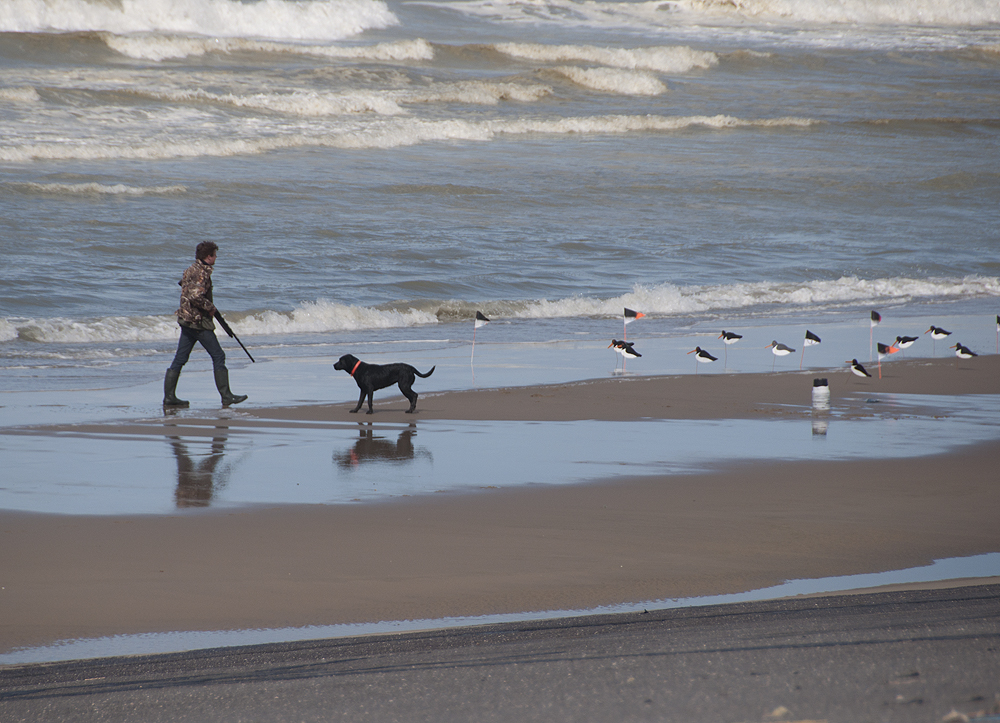
I am not sure if the seas were angry, but they certainly weren’t pleased about me setting up my spotting scope. My optics were pleading not to be led from the warm rental car to the fierce winds and sputters of driving rain outside.
I was in my last hours of my much-anticipated day of bird-watching in northern France. I had awoken in Paris before dawn to drive my rental Fiat 500 two hours north to the famous Parc Marquenterre, where flocks of migrating shorebirds awaited.
After careful research, I’d decided to spend the rest of the day looking out over the ocean towards the British Isles in hopes of spotting a passing murre, eider, or shearwater. My original plan was to check out several locations along the coast before pointing the car inland to Lille—on the Belgian borer—where I would rendezvous with Kristi to spend the weekend.
I glanced at my watch. As always, my original plan was ambitious. I really only had time for one stop. I decided to head straight for coastal city of Dunkerque, tempted by the pair of drivable breakwaters that jet out into the water I’d seen on Google Maps.
Without GPS, I was forced to use a less-detailed paper map and the position of the sun, which was fortunately prominent in the sky. After a few missed turns and multiple trips to the same roundabout, I found the jetty and unfortunately a seawatchers worst adversary: wind. While not as bad as its nefarious cousin, heavy rainfall, hard wind makes it difficult to hold a spotting scope steady, rendering impossible the already difficult task of identifying dark winged dots on the horizon.
I scanned the beach and the turbulent waters beyond from the comfort of the rental car. Fortunately, positioning the car was easy: the cement jetty was almost entirely drivable, save the last precipitous pitch as it met the beach.
Unfortunately, I couldn’t find much. I drove down to several more locations on the jetty: nothing.
As I approached a small group of empty cars, I was startled to see a man, perched on top of coastal boulders with a shotgun resting on his shoulder. Quite different from the beach tools I am used to seeing, the most insidious being a shovel or clam rake.

There’s no way he could get a decent shot at a seaduck. Was it target practice? His similarly-armed friend approached with a limp gray body dangling from his left hand. Still at a distance, I had to use my binoculars to identify their quarry: Black-tailed Godwit, a large sandpiper.
I was shocked. Certainly they can’t hunt shorebirds in France, can they? It did explain the lack of birds on this beach. Seeing similar clusters of cars down the jetty confirmed that the sport was at least popular, if not also legal.
I drove further down the jetty and stopped just short of vividly patterned flock of black and white Eurasian Oystercatchers. I quickly brought my binoculars to my eyes, excited to study a species I hadn’t ever seen before that morning. Hmph. Hunting decoys. A man paced the waterline near the decoys, shotgun on one side, dog on the other.

Tactically, the location was perfect. This wide amalgam of sand, cement, and rocks was the first land migrating shorebirds would see after leaving the tip of Scandinavia 500 miles to the north.
In the United States, we are used to hunting waterfowl and gamebirds like quail and pheasant; all other species are protected by the International Migratory Bird Treaty. It was a surprise to see some of the longest distance avian migrants in the crosshairs.

Despite a more generous target list, hunting is tightly regulated in France. Every hunter must have a valid license. Applicants must pass a written exam to test their knowledge of wildlife, hunting, hunting regulations, arms and munitions, and firearm safety. After passing, the applicant must take a practical exam which involves simulated hunting (with blanks) as well as live target practice with black targets representing legally hunted wildlife and red targets representing protected species. In addition to failing the above tests, applicants can be denied for medical reasons, or by having a criminal record within the past five years.
Once they pass, they can join the hunting community in France, which is well over a million strong. Following hunting seasons set by local prefectures, people can hunt any of the 62 bird species below.
| Waterfowl | ||
| Greater White-fronted Goose Graylag Goose Canada Goose Gadwall Eurasian Wigeon Mallard |
Northern Shoveler Northern Pintail Garganey Red-crested Pochard Common Pochard Tufted Duck |
Greater Scaup Common Eider White-winged Scoter Black Scoter Long-tailed Duck Common Goldeneye |
| Gallinaceous (“Chicken-like”) Birds | ||
| California Quail Northern Bobwhite Rock Partridge Red-legged Partridge Gray Partridge Common Quail |
Silver Pheasant Reeves’s Pheasant Ring-necked Pheasant Eurasian Capercaillie Black Grouse Hazel Grouse |
Willow Ptarmigan Rock Ptarmigan |
| Rails | ||
| Water Rail Eurasian Moorhen Eurasian Coot |
||
| Shorebirds | ||
| Northern Lapwing Black-bellied Plover European Golden-Plover Eurasian Oystercatcher Spotted Redshank Common Greenshank |
Common Redshank Whimbrel Eurasian Curlew Black-tailed Godwit Bar-tailed Godwit Red Knot |
Ruff Jack Snipe Common Snipe Eurasian Woodcock |
| Pigeons/Doves | ||
| Rock Pigeon Stock Dove Common Wood-Pigeon European Turtle-Dove Eurasian Collared-Dove |
||
| Corvids | ||
| Eurasian Jay Eurasian Magpie Eurasian Jackdaw Rook Carrion Crow |
||
| Songbirds | ||
| Sky Lark Eurasian Blackbird Fieldfare Redwing Mistle Thrush European Starling |
||
Sources:
- http://www.chasses-du-monde.com/europe/especes-chassees/index.html
- http://riviera.angloinfo.com/information/lifestyle/sports-and-leisure/hunting

Good heavens!! That sounds like the 1900s, not 2012. Please tell me they are using lead free shot,though I imagine they are polluting, poisoning AND killing.
Don’t get me started…I came across a hunter yesterday with 10 Dunlin and 2 GRYE dangling from his belt. He told me they were “Snipe”.
Arggg!